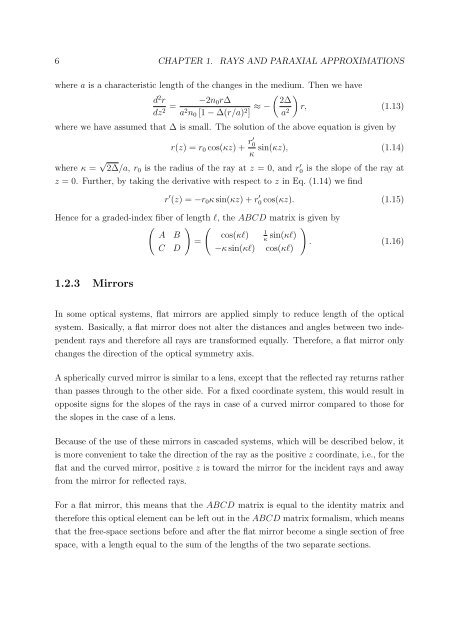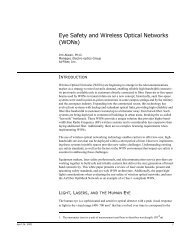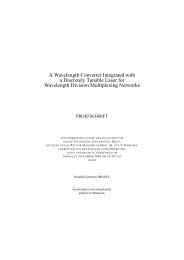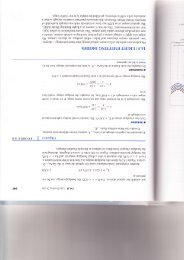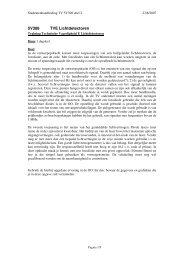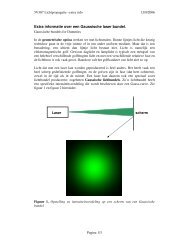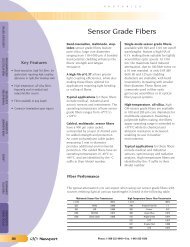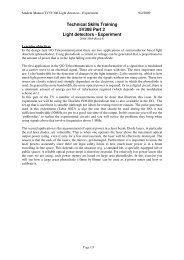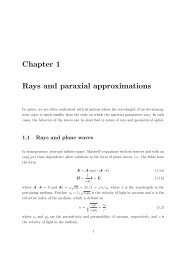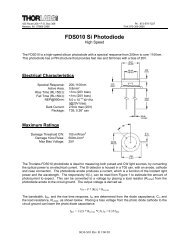Chapter 1 Rays and paraxial approximations - OED
Chapter 1 Rays and paraxial approximations - OED
Chapter 1 Rays and paraxial approximations - OED
Create successful ePaper yourself
Turn your PDF publications into a flip-book with our unique Google optimized e-Paper software.
6 CHAPTER 1. RAYS AND PARAXIAL APPROXIMATIONS<br />
where a is a characteristic length of the changes in the medium. Then we have<br />
d2r −2n0r∆<br />
=<br />
dz2 a2n0 [1 − ∆(r/a) 2 <br />
2∆<br />
≈ −<br />
] a2 <br />
r, (1.13)<br />
where we have assumed that ∆ is small. The solution of the above equation is given by<br />
r(z) = r0 cos(κz) + r′ 0<br />
κ<br />
sin(κz), (1.14)<br />
where κ = √ 2∆/a, r0 is the radius of the ray at z = 0, <strong>and</strong> r ′ 0 is the slope of the ray at<br />
z = 0. Further, by taking the derivative with respect to z in Eq. (1.14) we find<br />
r ′ (z) = −r0κ sin(κz) + r ′ 0 cos(κz). (1.15)<br />
Hence for a graded-index fiber of length ℓ, the ABCD matrix is given by<br />
<br />
1<br />
A B cos(κℓ) κ =<br />
C D<br />
sin(κℓ)<br />
<br />
. (1.16)<br />
−κ sin(κℓ) cos(κℓ)<br />
1.2.3 Mirrors<br />
In some optical systems, flat mirrors are applied simply to reduce length of the optical<br />
system. Basically, a flat mirror does not alter the distances <strong>and</strong> angles between two inde-<br />
pendent rays <strong>and</strong> therefore all rays are transformed equally. Therefore, a flat mirror only<br />
changes the direction of the optical symmetry axis.<br />
A spherically curved mirror is similar to a lens, except that the reflected ray returns rather<br />
than passes through to the other side. For a fixed coordinate system, this would result in<br />
opposite signs for the slopes of the rays in case of a curved mirror compared to those for<br />
the slopes in the case of a lens.<br />
Because of the use of these mirrors in cascaded systems, which will be described below, it<br />
is more convenient to take the direction of the ray as the positive z coordinate, i.e., for the<br />
flat <strong>and</strong> the curved mirror, positive z is toward the mirror for the incident rays <strong>and</strong> away<br />
from the mirror for reflected rays.<br />
For a flat mirror, this means that the ABCD matrix is equal to the identity matrix <strong>and</strong><br />
therefore this optical element can be left out in the ABCD matrix formalism, which means<br />
that the free-space sections before <strong>and</strong> after the flat mirror become a single section of free<br />
space, with a length equal to the sum of the lengths of the two separate sections.


